Analysis of Teaching, Learning, and Assessment in Education Report
VerifiedAdded on 2021/02/20
|14
|3055
|45
Report
AI Summary
This report delves into the core elements of teaching, learning, and assessment within an educational context. It identifies issues, explores various learning and assessment methods, and proposes solutions to enhance the learning experience. The report examines the importance of understanding individual learner needs, utilizing initial and diagnostic assessments, and promoting inclusive teaching practices. It covers different teaching and learning approaches, communication methods, and the use of resources. The report also discusses various assessment types, methods, and the importance of communication among professionals and stakeholders. Furthermore, it addresses the integration of core learning elements, the roles and responsibilities of educators, relevant legislation, and the impact of various factors on learners' capabilities, ultimately providing insights and strategies for effective education and training. This report is contributed by a student and available on Desklib, which offers resources for students.
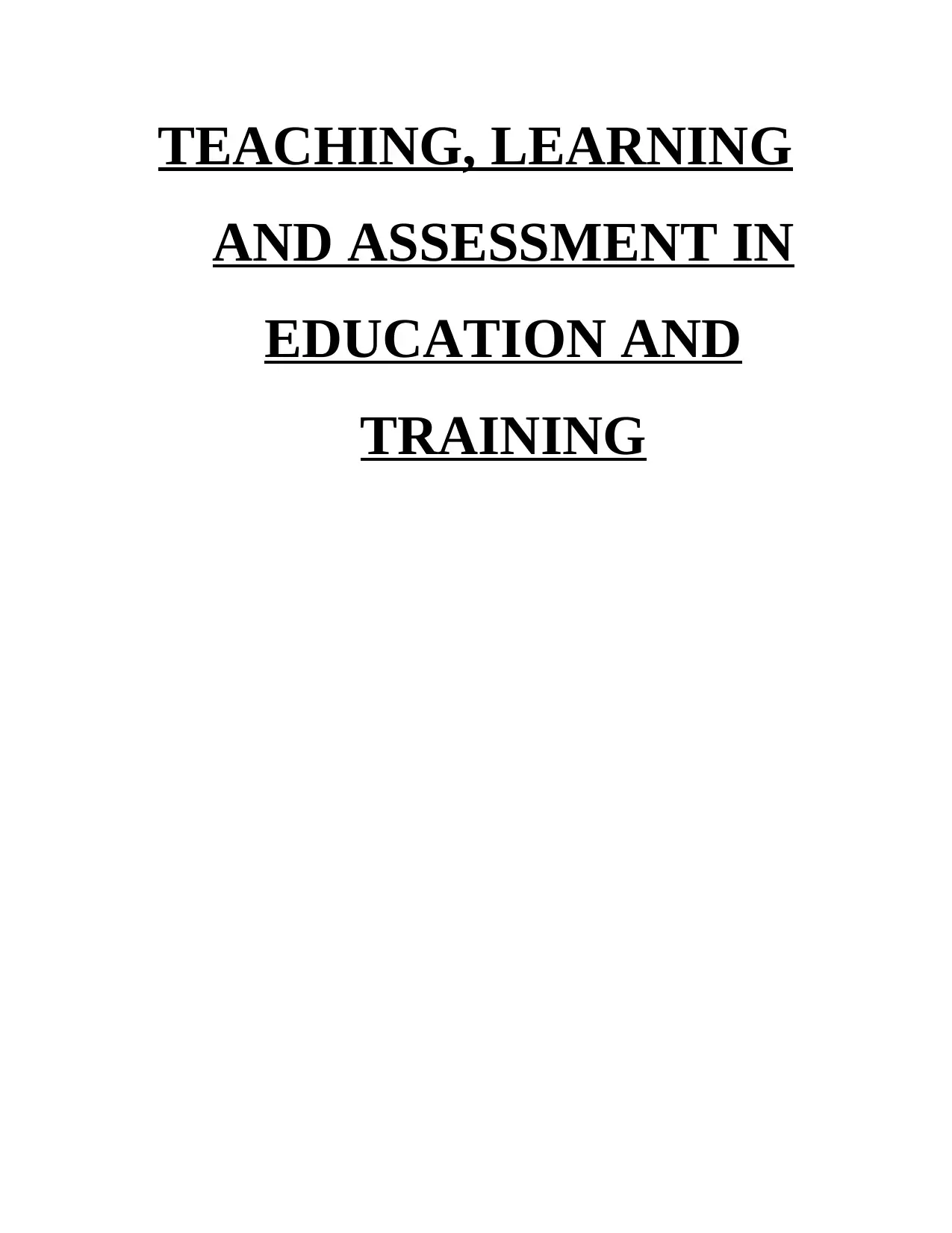
TEACHING, LEARNING
AND ASSESSMENT IN
EDUCATION AND
TRAINING
AND ASSESSMENT IN
EDUCATION AND
TRAINING
Paraphrase This Document
Need a fresh take? Get an instant paraphrase of this document with our AI Paraphraser
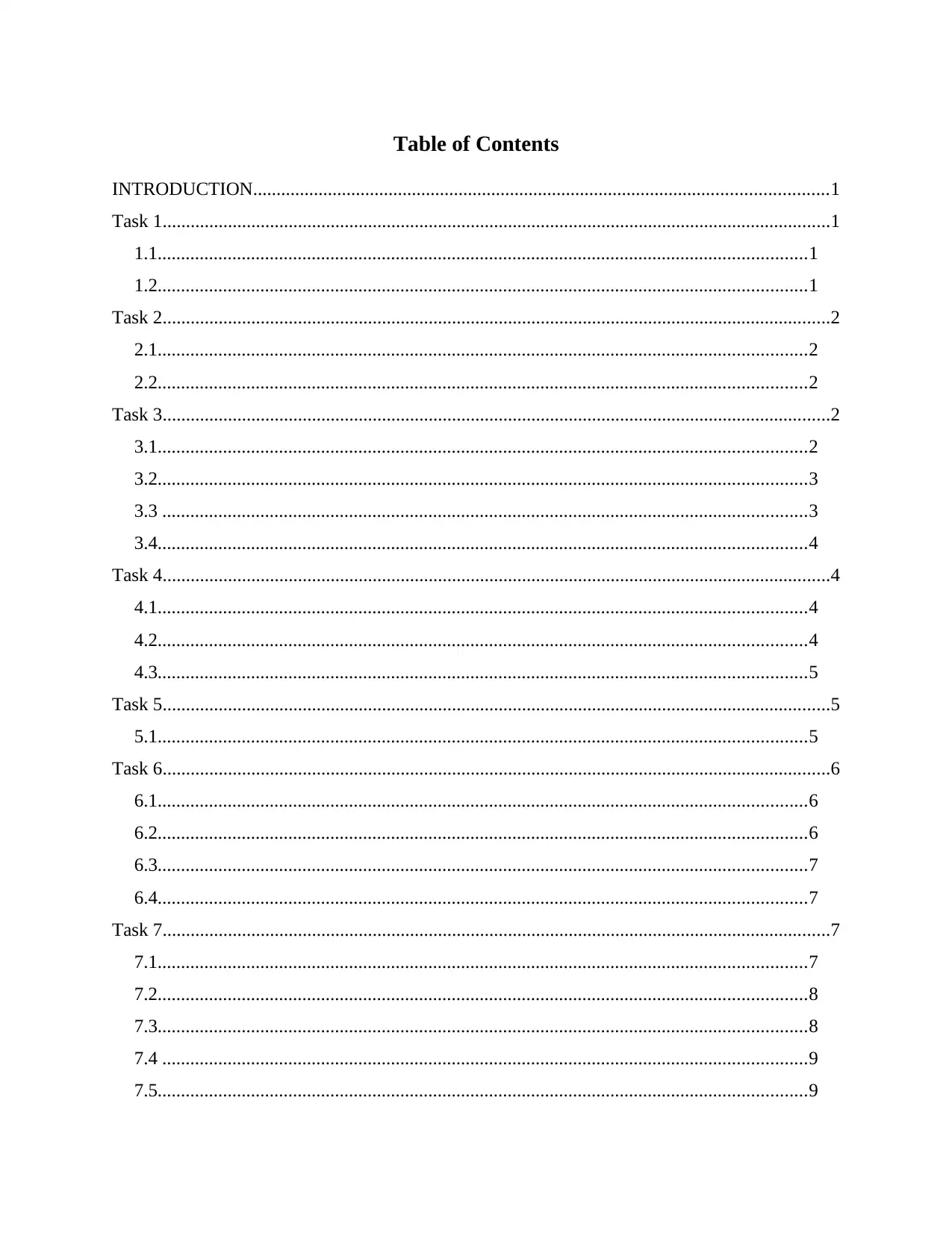
Table of Contents
INTRODUCTION...........................................................................................................................1
Task 1...............................................................................................................................................1
1.1...........................................................................................................................................1
1.2...........................................................................................................................................1
Task 2...............................................................................................................................................2
2.1...........................................................................................................................................2
2.2...........................................................................................................................................2
Task 3...............................................................................................................................................2
3.1...........................................................................................................................................2
3.2...........................................................................................................................................3
3.3 ..........................................................................................................................................3
3.4...........................................................................................................................................4
Task 4...............................................................................................................................................4
4.1...........................................................................................................................................4
4.2...........................................................................................................................................4
4.3...........................................................................................................................................5
Task 5...............................................................................................................................................5
5.1...........................................................................................................................................5
Task 6...............................................................................................................................................6
6.1...........................................................................................................................................6
6.2...........................................................................................................................................6
6.3...........................................................................................................................................7
6.4...........................................................................................................................................7
Task 7...............................................................................................................................................7
7.1...........................................................................................................................................7
7.2...........................................................................................................................................8
7.3...........................................................................................................................................8
7.4 ..........................................................................................................................................9
7.5...........................................................................................................................................9
INTRODUCTION...........................................................................................................................1
Task 1...............................................................................................................................................1
1.1...........................................................................................................................................1
1.2...........................................................................................................................................1
Task 2...............................................................................................................................................2
2.1...........................................................................................................................................2
2.2...........................................................................................................................................2
Task 3...............................................................................................................................................2
3.1...........................................................................................................................................2
3.2...........................................................................................................................................3
3.3 ..........................................................................................................................................3
3.4...........................................................................................................................................4
Task 4...............................................................................................................................................4
4.1...........................................................................................................................................4
4.2...........................................................................................................................................4
4.3...........................................................................................................................................5
Task 5...............................................................................................................................................5
5.1...........................................................................................................................................5
Task 6...............................................................................................................................................6
6.1...........................................................................................................................................6
6.2...........................................................................................................................................6
6.3...........................................................................................................................................7
6.4...........................................................................................................................................7
Task 7...............................................................................................................................................7
7.1...........................................................................................................................................7
7.2...........................................................................................................................................8
7.3...........................................................................................................................................8
7.4 ..........................................................................................................................................9
7.5...........................................................................................................................................9
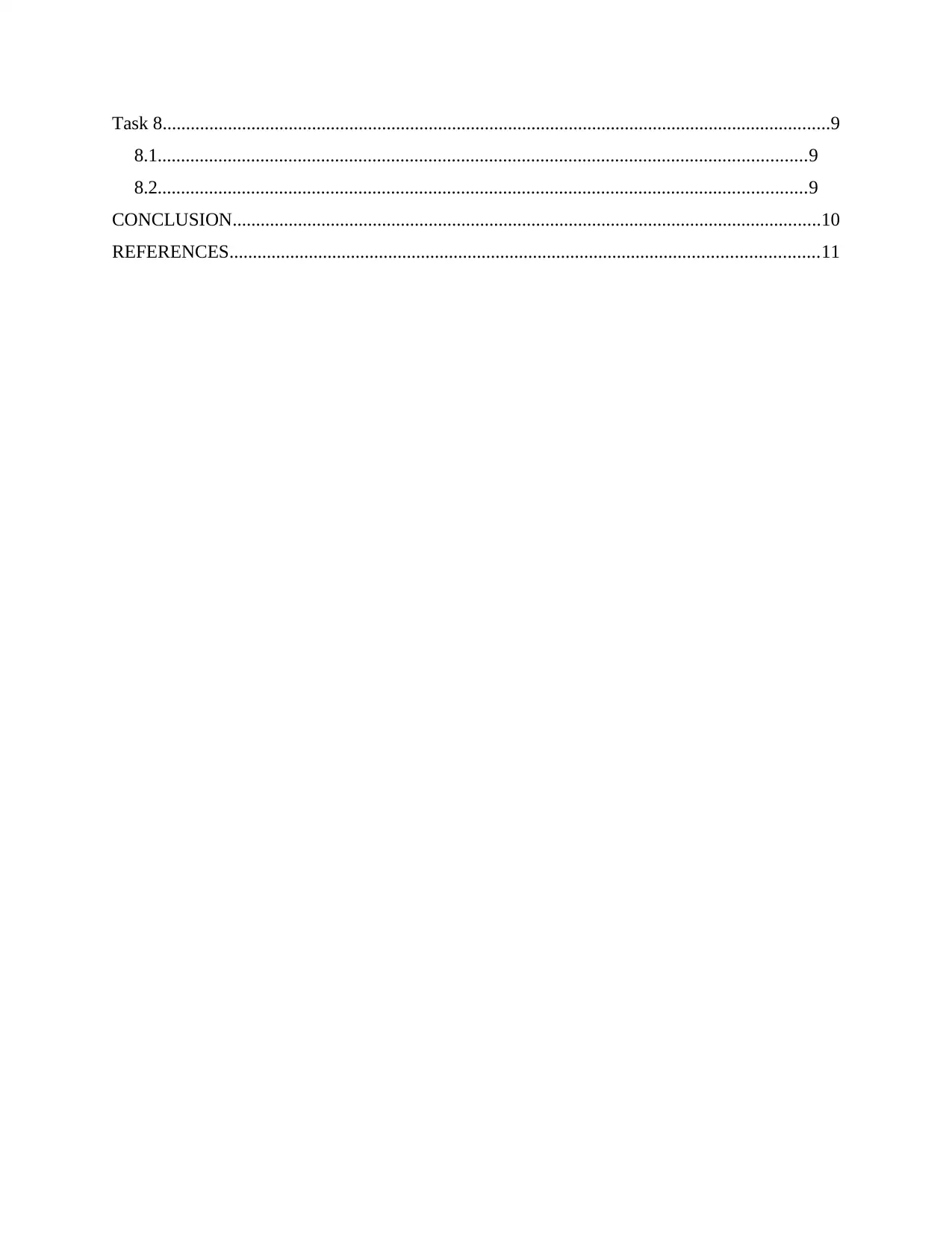
Task 8...............................................................................................................................................9
8.1...........................................................................................................................................9
8.2...........................................................................................................................................9
CONCLUSION..............................................................................................................................10
REFERENCES..............................................................................................................................11
8.1...........................................................................................................................................9
8.2...........................................................................................................................................9
CONCLUSION..............................................................................................................................10
REFERENCES..............................................................................................................................11
⊘ This is a preview!⊘
Do you want full access?
Subscribe today to unlock all pages.

Trusted by 1+ million students worldwide
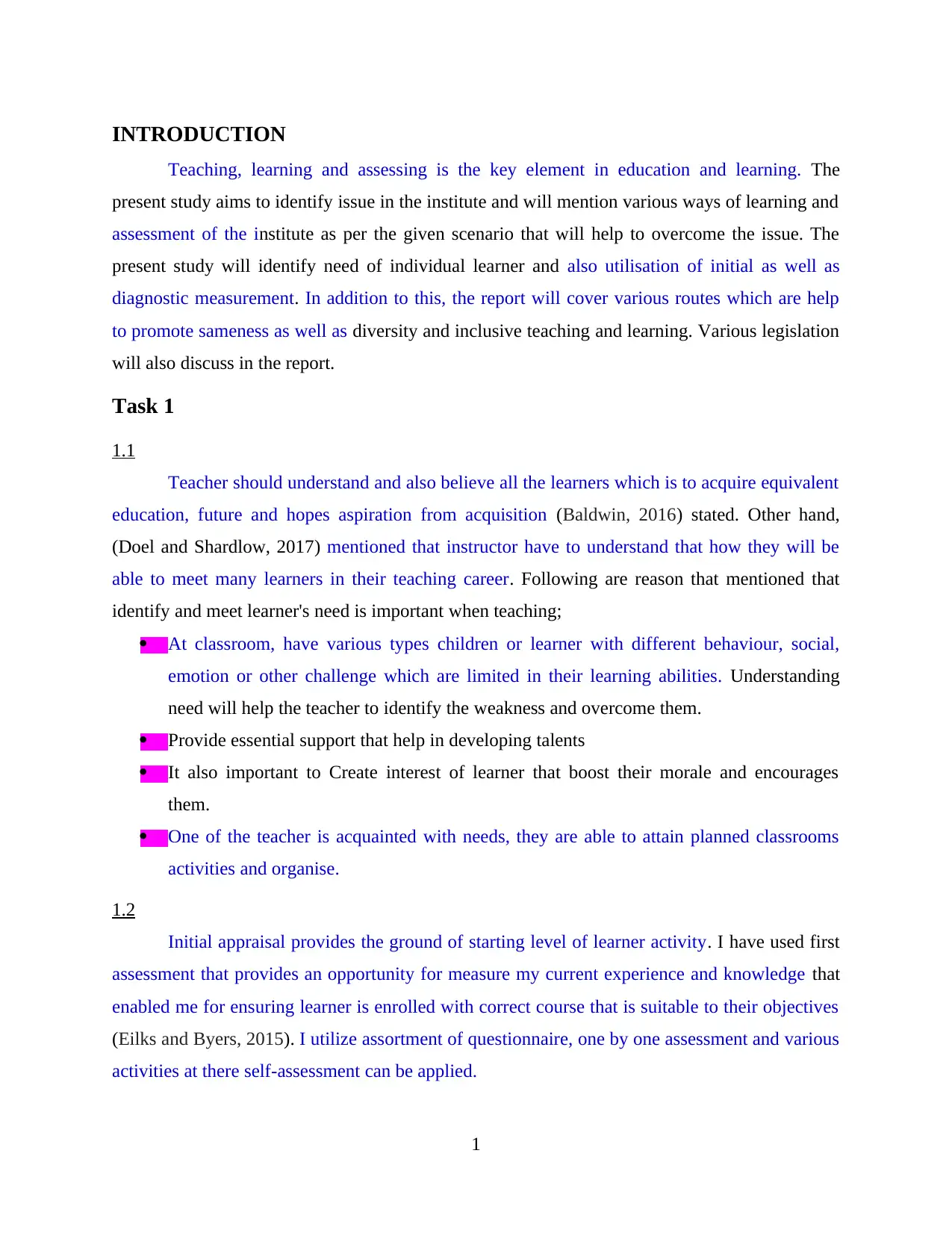
INTRODUCTION
Teaching, learning and assessing is the key element in education and learning. The
present study aims to identify issue in the institute and will mention various ways of learning and
assessment of the institute as per the given scenario that will help to overcome the issue. The
present study will identify need of individual learner and also utilisation of initial as well as
diagnostic measurement. In addition to this, the report will cover various routes which are help
to promote sameness as well as diversity and inclusive teaching and learning. Various legislation
will also discuss in the report.
Task 1
1.1
Teacher should understand and also believe all the learners which is to acquire equivalent
education, future and hopes aspiration from acquisition (Baldwin, 2016) stated. Other hand,
(Doel and Shardlow, 2017) mentioned that instructor have to understand that how they will be
able to meet many learners in their teaching career. Following are reason that mentioned that
identify and meet learner's need is important when teaching;
At classroom, have various types children or learner with different behaviour, social,
emotion or other challenge which are limited in their learning abilities. Understanding
need will help the teacher to identify the weakness and overcome them.
Provide essential support that help in developing talents
It also important to Create interest of learner that boost their morale and encourages
them.
One of the teacher is acquainted with needs, they are able to attain planned classrooms
activities and organise.
1.2
Initial appraisal provides the ground of starting level of learner activity. I have used first
assessment that provides an opportunity for measure my current experience and knowledge that
enabled me for ensuring learner is enrolled with correct course that is suitable to their objectives
(Eilks and Byers, 2015). I utilize assortment of questionnaire, one by one assessment and various
activities at there self-assessment can be applied.
1
Teaching, learning and assessing is the key element in education and learning. The
present study aims to identify issue in the institute and will mention various ways of learning and
assessment of the institute as per the given scenario that will help to overcome the issue. The
present study will identify need of individual learner and also utilisation of initial as well as
diagnostic measurement. In addition to this, the report will cover various routes which are help
to promote sameness as well as diversity and inclusive teaching and learning. Various legislation
will also discuss in the report.
Task 1
1.1
Teacher should understand and also believe all the learners which is to acquire equivalent
education, future and hopes aspiration from acquisition (Baldwin, 2016) stated. Other hand,
(Doel and Shardlow, 2017) mentioned that instructor have to understand that how they will be
able to meet many learners in their teaching career. Following are reason that mentioned that
identify and meet learner's need is important when teaching;
At classroom, have various types children or learner with different behaviour, social,
emotion or other challenge which are limited in their learning abilities. Understanding
need will help the teacher to identify the weakness and overcome them.
Provide essential support that help in developing talents
It also important to Create interest of learner that boost their morale and encourages
them.
One of the teacher is acquainted with needs, they are able to attain planned classrooms
activities and organise.
1.2
Initial appraisal provides the ground of starting level of learner activity. I have used first
assessment that provides an opportunity for measure my current experience and knowledge that
enabled me for ensuring learner is enrolled with correct course that is suitable to their objectives
(Eilks and Byers, 2015). I utilize assortment of questionnaire, one by one assessment and various
activities at there self-assessment can be applied.
1
Paraphrase This Document
Need a fresh take? Get an instant paraphrase of this document with our AI Paraphraser

Other hand, Diagnostic assessment process is incidental to particular skills which are help
to me for discover and target the specific learning area that is required to develop or improve to
achieve the learning objectives.
I used Initial assessment in beginning of the course and after finding the need I use
diagnostic assessment that provide current strength, knowledge and any areas for development.
Task 2
2.1
As learner take place at the social environment which is important for creating good
ambience where learner feel comfortable and safe to express their opinion. Promoting
appropriate behaviour is essential to eliminate any discrimination and inequality and to create a
relaxed environment where learners will be more focused and motivated. Promoting and creating
a culture will bring learner to a group and encourage every learner to put their creative and
innovative thought in front.
2.2
Equivalence is active for the rights of learner. It is very clear in Equality Act 2010 that
how everyone should treat all walks of life as well as if it comes for education or learning is rule
under Education of Equality Act 2010. This will help to Promote equality as well as diversity
which is essential for learners and teachers. It has been analysed through (How to Promote
Equality & Diversity in the Classroom, 2019) that students should be familiar with the term from
an early age. It can be promote through;
Setting clear rules
treating all the staff and learners equally and fairly
using various of teaching methods such as Telling stories
Celebrating all festivals together
Task 3
3.1
Both approaches are teaching and learning specific method which are used by teachers
for ease process of learning. This is essentially selected in an appropriate teaching and learning
approach enable for learners which is actively engaged in learning sessions and make the most
2
to me for discover and target the specific learning area that is required to develop or improve to
achieve the learning objectives.
I used Initial assessment in beginning of the course and after finding the need I use
diagnostic assessment that provide current strength, knowledge and any areas for development.
Task 2
2.1
As learner take place at the social environment which is important for creating good
ambience where learner feel comfortable and safe to express their opinion. Promoting
appropriate behaviour is essential to eliminate any discrimination and inequality and to create a
relaxed environment where learners will be more focused and motivated. Promoting and creating
a culture will bring learner to a group and encourage every learner to put their creative and
innovative thought in front.
2.2
Equivalence is active for the rights of learner. It is very clear in Equality Act 2010 that
how everyone should treat all walks of life as well as if it comes for education or learning is rule
under Education of Equality Act 2010. This will help to Promote equality as well as diversity
which is essential for learners and teachers. It has been analysed through (How to Promote
Equality & Diversity in the Classroom, 2019) that students should be familiar with the term from
an early age. It can be promote through;
Setting clear rules
treating all the staff and learners equally and fairly
using various of teaching methods such as Telling stories
Celebrating all festivals together
Task 3
3.1
Both approaches are teaching and learning specific method which are used by teachers
for ease process of learning. This is essentially selected in an appropriate teaching and learning
approach enable for learners which is actively engaged in learning sessions and make the most
2
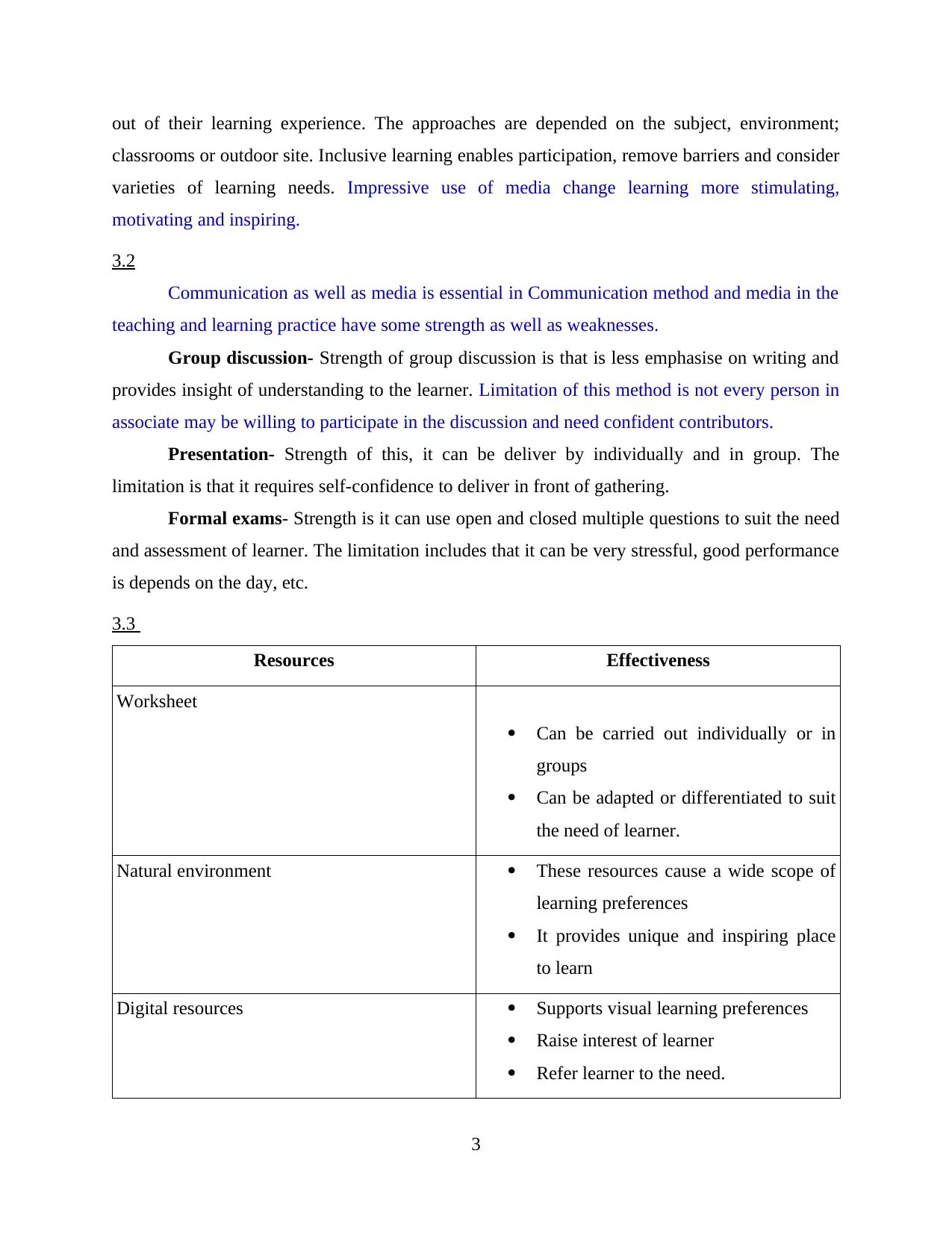
out of their learning experience. The approaches are depended on the subject, environment;
classrooms or outdoor site. Inclusive learning enables participation, remove barriers and consider
varieties of learning needs. Impressive use of media change learning more stimulating,
motivating and inspiring.
3.2
Communication as well as media is essential in Communication method and media in the
teaching and learning practice have some strength as well as weaknesses.
Group discussion- Strength of group discussion is that is less emphasise on writing and
provides insight of understanding to the learner. Limitation of this method is not every person in
associate may be willing to participate in the discussion and need confident contributors.
Presentation- Strength of this, it can be deliver by individually and in group. The
limitation is that it requires self-confidence to deliver in front of gathering.
Formal exams- Strength is it can use open and closed multiple questions to suit the need
and assessment of learner. The limitation includes that it can be very stressful, good performance
is depends on the day, etc.
3.3
Resources Effectiveness
Worksheet
Can be carried out individually or in
groups
Can be adapted or differentiated to suit
the need of learner.
Natural environment These resources cause a wide scope of
learning preferences
It provides unique and inspiring place
to learn
Digital resources Supports visual learning preferences
Raise interest of learner
Refer learner to the need.
3
classrooms or outdoor site. Inclusive learning enables participation, remove barriers and consider
varieties of learning needs. Impressive use of media change learning more stimulating,
motivating and inspiring.
3.2
Communication as well as media is essential in Communication method and media in the
teaching and learning practice have some strength as well as weaknesses.
Group discussion- Strength of group discussion is that is less emphasise on writing and
provides insight of understanding to the learner. Limitation of this method is not every person in
associate may be willing to participate in the discussion and need confident contributors.
Presentation- Strength of this, it can be deliver by individually and in group. The
limitation is that it requires self-confidence to deliver in front of gathering.
Formal exams- Strength is it can use open and closed multiple questions to suit the need
and assessment of learner. The limitation includes that it can be very stressful, good performance
is depends on the day, etc.
3.3
Resources Effectiveness
Worksheet
Can be carried out individually or in
groups
Can be adapted or differentiated to suit
the need of learner.
Natural environment These resources cause a wide scope of
learning preferences
It provides unique and inspiring place
to learn
Digital resources Supports visual learning preferences
Raise interest of learner
Refer learner to the need.
3
⊘ This is a preview!⊘
Do you want full access?
Subscribe today to unlock all pages.

Trusted by 1+ million students worldwide
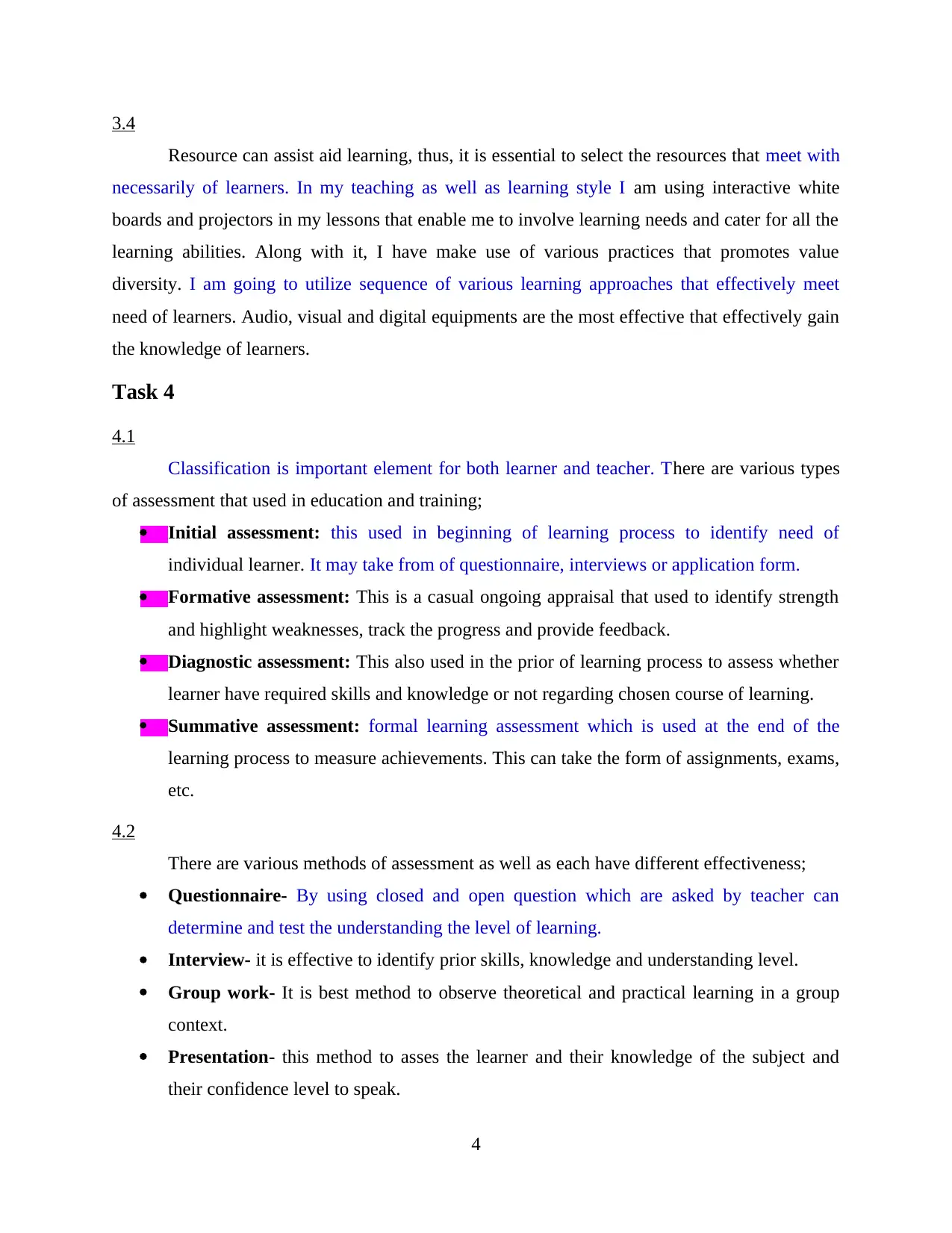
3.4
Resource can assist aid learning, thus, it is essential to select the resources that meet with
necessarily of learners. In my teaching as well as learning style I am using interactive white
boards and projectors in my lessons that enable me to involve learning needs and cater for all the
learning abilities. Along with it, I have make use of various practices that promotes value
diversity. I am going to utilize sequence of various learning approaches that effectively meet
need of learners. Audio, visual and digital equipments are the most effective that effectively gain
the knowledge of learners.
Task 4
4.1
Classification is important element for both learner and teacher. There are various types
of assessment that used in education and training;
Initial assessment: this used in beginning of learning process to identify need of
individual learner. It may take from of questionnaire, interviews or application form.
Formative assessment: This is a casual ongoing appraisal that used to identify strength
and highlight weaknesses, track the progress and provide feedback.
Diagnostic assessment: This also used in the prior of learning process to assess whether
learner have required skills and knowledge or not regarding chosen course of learning.
Summative assessment: formal learning assessment which is used at the end of the
learning process to measure achievements. This can take the form of assignments, exams,
etc.
4.2
There are various methods of assessment as well as each have different effectiveness;
Questionnaire- By using closed and open question which are asked by teacher can
determine and test the understanding the level of learning.
Interview- it is effective to identify prior skills, knowledge and understanding level.
Group work- It is best method to observe theoretical and practical learning in a group
context.
Presentation- this method to asses the learner and their knowledge of the subject and
their confidence level to speak.
4
Resource can assist aid learning, thus, it is essential to select the resources that meet with
necessarily of learners. In my teaching as well as learning style I am using interactive white
boards and projectors in my lessons that enable me to involve learning needs and cater for all the
learning abilities. Along with it, I have make use of various practices that promotes value
diversity. I am going to utilize sequence of various learning approaches that effectively meet
need of learners. Audio, visual and digital equipments are the most effective that effectively gain
the knowledge of learners.
Task 4
4.1
Classification is important element for both learner and teacher. There are various types
of assessment that used in education and training;
Initial assessment: this used in beginning of learning process to identify need of
individual learner. It may take from of questionnaire, interviews or application form.
Formative assessment: This is a casual ongoing appraisal that used to identify strength
and highlight weaknesses, track the progress and provide feedback.
Diagnostic assessment: This also used in the prior of learning process to assess whether
learner have required skills and knowledge or not regarding chosen course of learning.
Summative assessment: formal learning assessment which is used at the end of the
learning process to measure achievements. This can take the form of assignments, exams,
etc.
4.2
There are various methods of assessment as well as each have different effectiveness;
Questionnaire- By using closed and open question which are asked by teacher can
determine and test the understanding the level of learning.
Interview- it is effective to identify prior skills, knowledge and understanding level.
Group work- It is best method to observe theoretical and practical learning in a group
context.
Presentation- this method to asses the learner and their knowledge of the subject and
their confidence level to speak.
4
Paraphrase This Document
Need a fresh take? Get an instant paraphrase of this document with our AI Paraphraser
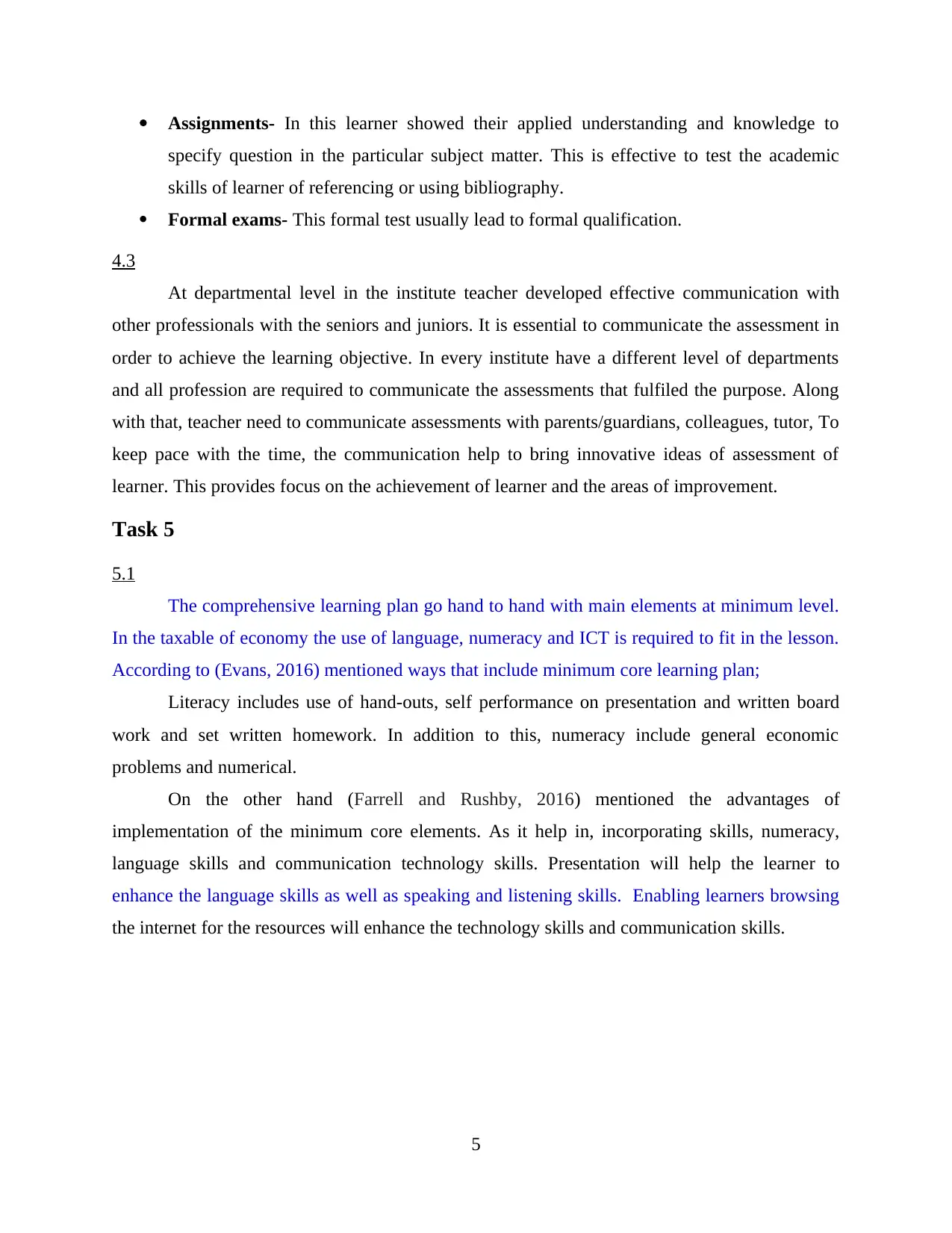
Assignments- In this learner showed their applied understanding and knowledge to
specify question in the particular subject matter. This is effective to test the academic
skills of learner of referencing or using bibliography.
Formal exams- This formal test usually lead to formal qualification.
4.3
At departmental level in the institute teacher developed effective communication with
other professionals with the seniors and juniors. It is essential to communicate the assessment in
order to achieve the learning objective. In every institute have a different level of departments
and all profession are required to communicate the assessments that fulfiled the purpose. Along
with that, teacher need to communicate assessments with parents/guardians, colleagues, tutor, To
keep pace with the time, the communication help to bring innovative ideas of assessment of
learner. This provides focus on the achievement of learner and the areas of improvement.
Task 5
5.1
The comprehensive learning plan go hand to hand with main elements at minimum level.
In the taxable of economy the use of language, numeracy and ICT is required to fit in the lesson.
According to (Evans, 2016) mentioned ways that include minimum core learning plan;
Literacy includes use of hand-outs, self performance on presentation and written board
work and set written homework. In addition to this, numeracy include general economic
problems and numerical.
On the other hand (Farrell and Rushby, 2016) mentioned the advantages of
implementation of the minimum core elements. As it help in, incorporating skills, numeracy,
language skills and communication technology skills. Presentation will help the learner to
enhance the language skills as well as speaking and listening skills. Enabling learners browsing
the internet for the resources will enhance the technology skills and communication skills.
5
specify question in the particular subject matter. This is effective to test the academic
skills of learner of referencing or using bibliography.
Formal exams- This formal test usually lead to formal qualification.
4.3
At departmental level in the institute teacher developed effective communication with
other professionals with the seniors and juniors. It is essential to communicate the assessment in
order to achieve the learning objective. In every institute have a different level of departments
and all profession are required to communicate the assessments that fulfiled the purpose. Along
with that, teacher need to communicate assessments with parents/guardians, colleagues, tutor, To
keep pace with the time, the communication help to bring innovative ideas of assessment of
learner. This provides focus on the achievement of learner and the areas of improvement.
Task 5
5.1
The comprehensive learning plan go hand to hand with main elements at minimum level.
In the taxable of economy the use of language, numeracy and ICT is required to fit in the lesson.
According to (Evans, 2016) mentioned ways that include minimum core learning plan;
Literacy includes use of hand-outs, self performance on presentation and written board
work and set written homework. In addition to this, numeracy include general economic
problems and numerical.
On the other hand (Farrell and Rushby, 2016) mentioned the advantages of
implementation of the minimum core elements. As it help in, incorporating skills, numeracy,
language skills and communication technology skills. Presentation will help the learner to
enhance the language skills as well as speaking and listening skills. Enabling learners browsing
the internet for the resources will enhance the technology skills and communication skills.
5
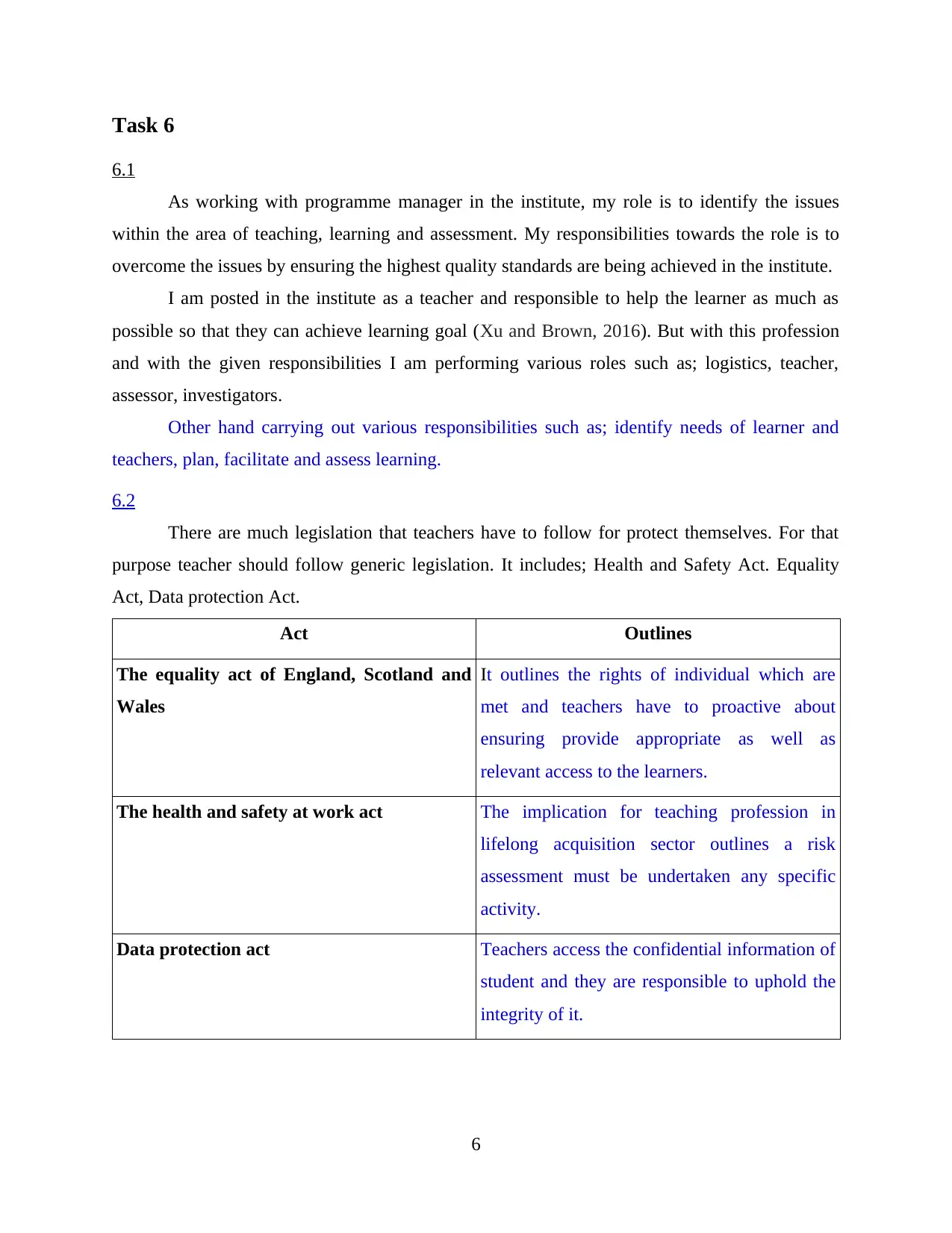
Task 6
6.1
As working with programme manager in the institute, my role is to identify the issues
within the area of teaching, learning and assessment. My responsibilities towards the role is to
overcome the issues by ensuring the highest quality standards are being achieved in the institute.
I am posted in the institute as a teacher and responsible to help the learner as much as
possible so that they can achieve learning goal (Xu and Brown, 2016). But with this profession
and with the given responsibilities I am performing various roles such as; logistics, teacher,
assessor, investigators.
Other hand carrying out various responsibilities such as; identify needs of learner and
teachers, plan, facilitate and assess learning.
6.2
There are much legislation that teachers have to follow for protect themselves. For that
purpose teacher should follow generic legislation. It includes; Health and Safety Act. Equality
Act, Data protection Act.
Act Outlines
The equality act of England, Scotland and
Wales
It outlines the rights of individual which are
met and teachers have to proactive about
ensuring provide appropriate as well as
relevant access to the learners.
The health and safety at work act The implication for teaching profession in
lifelong acquisition sector outlines a risk
assessment must be undertaken any specific
activity.
Data protection act Teachers access the confidential information of
student and they are responsible to uphold the
integrity of it.
6
6.1
As working with programme manager in the institute, my role is to identify the issues
within the area of teaching, learning and assessment. My responsibilities towards the role is to
overcome the issues by ensuring the highest quality standards are being achieved in the institute.
I am posted in the institute as a teacher and responsible to help the learner as much as
possible so that they can achieve learning goal (Xu and Brown, 2016). But with this profession
and with the given responsibilities I am performing various roles such as; logistics, teacher,
assessor, investigators.
Other hand carrying out various responsibilities such as; identify needs of learner and
teachers, plan, facilitate and assess learning.
6.2
There are much legislation that teachers have to follow for protect themselves. For that
purpose teacher should follow generic legislation. It includes; Health and Safety Act. Equality
Act, Data protection Act.
Act Outlines
The equality act of England, Scotland and
Wales
It outlines the rights of individual which are
met and teachers have to proactive about
ensuring provide appropriate as well as
relevant access to the learners.
The health and safety at work act The implication for teaching profession in
lifelong acquisition sector outlines a risk
assessment must be undertaken any specific
activity.
Data protection act Teachers access the confidential information of
student and they are responsible to uphold the
integrity of it.
6
⊘ This is a preview!⊘
Do you want full access?
Subscribe today to unlock all pages.

Trusted by 1+ million students worldwide
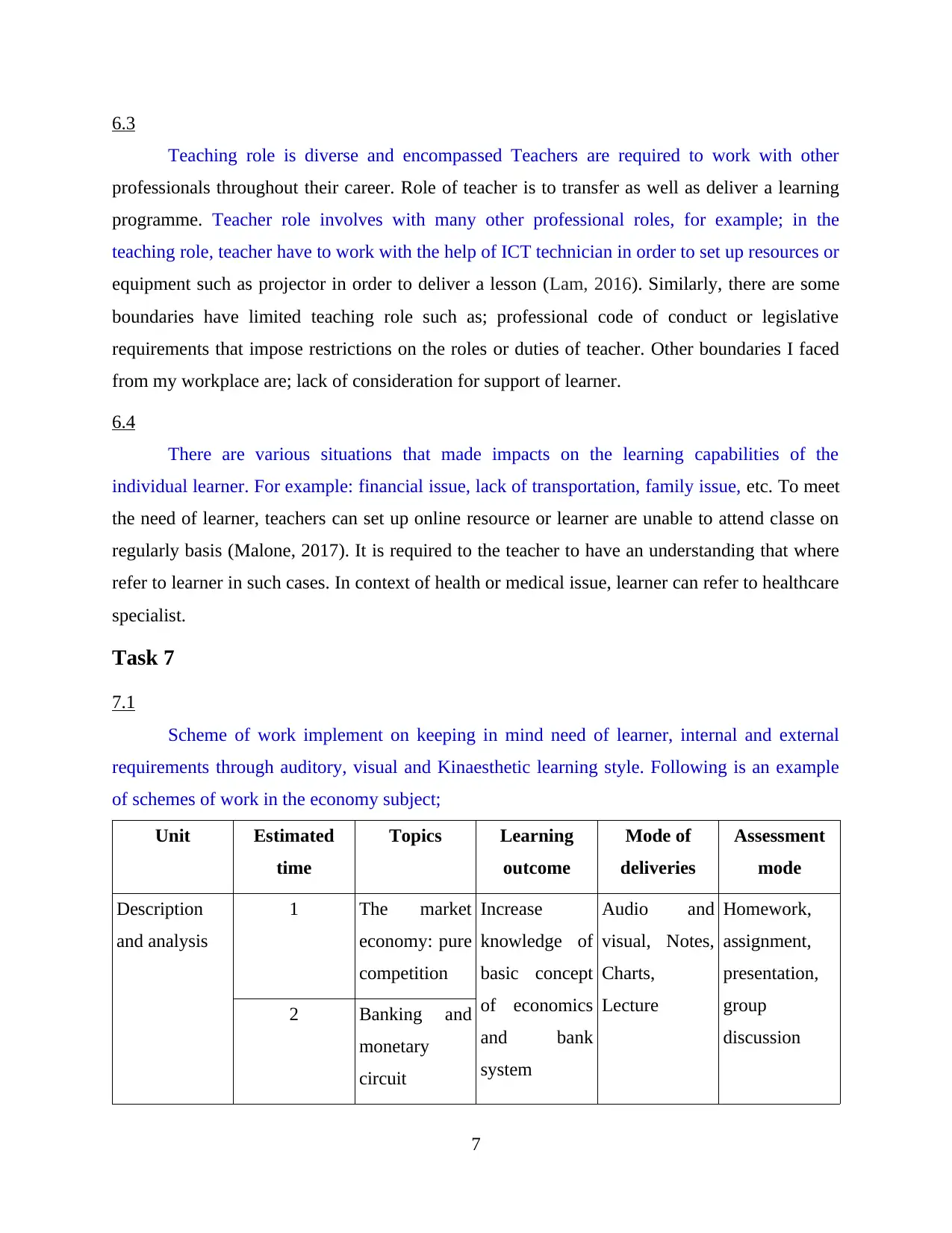
6.3
Teaching role is diverse and encompassed Teachers are required to work with other
professionals throughout their career. Role of teacher is to transfer as well as deliver a learning
programme. Teacher role involves with many other professional roles, for example; in the
teaching role, teacher have to work with the help of ICT technician in order to set up resources or
equipment such as projector in order to deliver a lesson (Lam, 2016). Similarly, there are some
boundaries have limited teaching role such as; professional code of conduct or legislative
requirements that impose restrictions on the roles or duties of teacher. Other boundaries I faced
from my workplace are; lack of consideration for support of learner.
6.4
There are various situations that made impacts on the learning capabilities of the
individual learner. For example: financial issue, lack of transportation, family issue, etc. To meet
the need of learner, teachers can set up online resource or learner are unable to attend classe on
regularly basis (Malone, 2017). It is required to the teacher to have an understanding that where
refer to learner in such cases. In context of health or medical issue, learner can refer to healthcare
specialist.
Task 7
7.1
Scheme of work implement on keeping in mind need of learner, internal and external
requirements through auditory, visual and Kinaesthetic learning style. Following is an example
of schemes of work in the economy subject;
Unit Estimated
time
Topics Learning
outcome
Mode of
deliveries
Assessment
mode
Description
and analysis
1 The market
economy: pure
competition
Increase
knowledge of
basic concept
of economics
and bank
system
Audio and
visual, Notes,
Charts,
Lecture
Homework,
assignment,
presentation,
group
discussion
2 Banking and
monetary
circuit
7
Teaching role is diverse and encompassed Teachers are required to work with other
professionals throughout their career. Role of teacher is to transfer as well as deliver a learning
programme. Teacher role involves with many other professional roles, for example; in the
teaching role, teacher have to work with the help of ICT technician in order to set up resources or
equipment such as projector in order to deliver a lesson (Lam, 2016). Similarly, there are some
boundaries have limited teaching role such as; professional code of conduct or legislative
requirements that impose restrictions on the roles or duties of teacher. Other boundaries I faced
from my workplace are; lack of consideration for support of learner.
6.4
There are various situations that made impacts on the learning capabilities of the
individual learner. For example: financial issue, lack of transportation, family issue, etc. To meet
the need of learner, teachers can set up online resource or learner are unable to attend classe on
regularly basis (Malone, 2017). It is required to the teacher to have an understanding that where
refer to learner in such cases. In context of health or medical issue, learner can refer to healthcare
specialist.
Task 7
7.1
Scheme of work implement on keeping in mind need of learner, internal and external
requirements through auditory, visual and Kinaesthetic learning style. Following is an example
of schemes of work in the economy subject;
Unit Estimated
time
Topics Learning
outcome
Mode of
deliveries
Assessment
mode
Description
and analysis
1 The market
economy: pure
competition
Increase
knowledge of
basic concept
of economics
and bank
system
Audio and
visual, Notes,
Charts,
Lecture
Homework,
assignment,
presentation,
group
discussion
2 Banking and
monetary
circuit
7
Paraphrase This Document
Need a fresh take? Get an instant paraphrase of this document with our AI Paraphraser

Project 3 Research Project
submission
7.2
Subject: Economics
Topic: Economic local level issue
Duration: 2.5 Hours
Number of learner: 35
Learning aids: white board, duster, marker, notes, projector
Aim: to enable learns to enhance the knowledge ongoing economic problems at local level
Time Division:
Lecture- 40 minutes
Activities- 35 minutes
special education needs- 15 minutes
ending notes- 5 minutes
Goals and needs of all learners
It is essential for understand individual needs as well as curriculum requirements of the
learners and identify if any learner is required extra support. To address the goals and needs of
individuals, teachers should provide them various learning opportunities through diversified
resources and adopt various modes learning style. Teachers has responsibility for identify the
strength and weakness of learners.
Curriculum requirements
Individual and group learners required curriculum requirement that engaged learners in
the beginning learning process of 40 minutes as well as special education need 15 minutes that
aim to fulfil need regarding learner of the individual learners. Power point presentation,
provision of notes and any special aid help in the completion of the lesson plan.
7.3
Through developing alternatives of learning method and providing online handbooks and
classes assist the learners who are unable to come to the lecture due to any personal issue. Along
8
submission
7.2
Subject: Economics
Topic: Economic local level issue
Duration: 2.5 Hours
Number of learner: 35
Learning aids: white board, duster, marker, notes, projector
Aim: to enable learns to enhance the knowledge ongoing economic problems at local level
Time Division:
Lecture- 40 minutes
Activities- 35 minutes
special education needs- 15 minutes
ending notes- 5 minutes
Goals and needs of all learners
It is essential for understand individual needs as well as curriculum requirements of the
learners and identify if any learner is required extra support. To address the goals and needs of
individuals, teachers should provide them various learning opportunities through diversified
resources and adopt various modes learning style. Teachers has responsibility for identify the
strength and weakness of learners.
Curriculum requirements
Individual and group learners required curriculum requirement that engaged learners in
the beginning learning process of 40 minutes as well as special education need 15 minutes that
aim to fulfil need regarding learner of the individual learners. Power point presentation,
provision of notes and any special aid help in the completion of the lesson plan.
7.3
Through developing alternatives of learning method and providing online handbooks and
classes assist the learners who are unable to come to the lecture due to any personal issue. Along
8
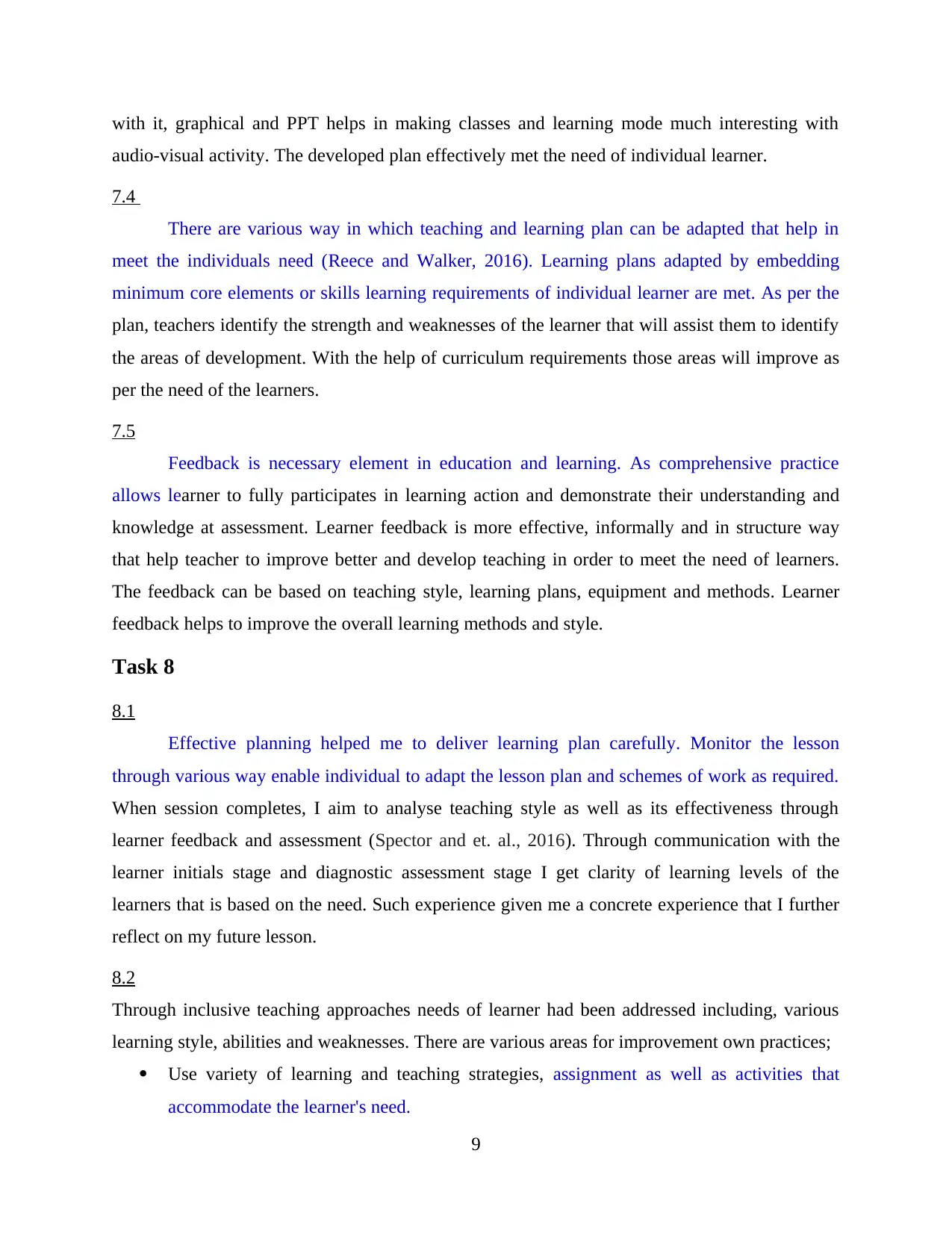
with it, graphical and PPT helps in making classes and learning mode much interesting with
audio-visual activity. The developed plan effectively met the need of individual learner.
7.4
There are various way in which teaching and learning plan can be adapted that help in
meet the individuals need (Reece and Walker, 2016). Learning plans adapted by embedding
minimum core elements or skills learning requirements of individual learner are met. As per the
plan, teachers identify the strength and weaknesses of the learner that will assist them to identify
the areas of development. With the help of curriculum requirements those areas will improve as
per the need of the learners.
7.5
Feedback is necessary element in education and learning. As comprehensive practice
allows learner to fully participates in learning action and demonstrate their understanding and
knowledge at assessment. Learner feedback is more effective, informally and in structure way
that help teacher to improve better and develop teaching in order to meet the need of learners.
The feedback can be based on teaching style, learning plans, equipment and methods. Learner
feedback helps to improve the overall learning methods and style.
Task 8
8.1
Effective planning helped me to deliver learning plan carefully. Monitor the lesson
through various way enable individual to adapt the lesson plan and schemes of work as required.
When session completes, I aim to analyse teaching style as well as its effectiveness through
learner feedback and assessment (Spector and et. al., 2016). Through communication with the
learner initials stage and diagnostic assessment stage I get clarity of learning levels of the
learners that is based on the need. Such experience given me a concrete experience that I further
reflect on my future lesson.
8.2
Through inclusive teaching approaches needs of learner had been addressed including, various
learning style, abilities and weaknesses. There are various areas for improvement own practices;
Use variety of learning and teaching strategies, assignment as well as activities that
accommodate the learner's need.
9
audio-visual activity. The developed plan effectively met the need of individual learner.
7.4
There are various way in which teaching and learning plan can be adapted that help in
meet the individuals need (Reece and Walker, 2016). Learning plans adapted by embedding
minimum core elements or skills learning requirements of individual learner are met. As per the
plan, teachers identify the strength and weaknesses of the learner that will assist them to identify
the areas of development. With the help of curriculum requirements those areas will improve as
per the need of the learners.
7.5
Feedback is necessary element in education and learning. As comprehensive practice
allows learner to fully participates in learning action and demonstrate their understanding and
knowledge at assessment. Learner feedback is more effective, informally and in structure way
that help teacher to improve better and develop teaching in order to meet the need of learners.
The feedback can be based on teaching style, learning plans, equipment and methods. Learner
feedback helps to improve the overall learning methods and style.
Task 8
8.1
Effective planning helped me to deliver learning plan carefully. Monitor the lesson
through various way enable individual to adapt the lesson plan and schemes of work as required.
When session completes, I aim to analyse teaching style as well as its effectiveness through
learner feedback and assessment (Spector and et. al., 2016). Through communication with the
learner initials stage and diagnostic assessment stage I get clarity of learning levels of the
learners that is based on the need. Such experience given me a concrete experience that I further
reflect on my future lesson.
8.2
Through inclusive teaching approaches needs of learner had been addressed including, various
learning style, abilities and weaknesses. There are various areas for improvement own practices;
Use variety of learning and teaching strategies, assignment as well as activities that
accommodate the learner's need.
9
⊘ This is a preview!⊘
Do you want full access?
Subscribe today to unlock all pages.

Trusted by 1+ million students worldwide
1 out of 14
Related Documents
Your All-in-One AI-Powered Toolkit for Academic Success.
+13062052269
info@desklib.com
Available 24*7 on WhatsApp / Email
![[object Object]](/_next/static/media/star-bottom.7253800d.svg)
Unlock your academic potential
Copyright © 2020–2025 A2Z Services. All Rights Reserved. Developed and managed by ZUCOL.


